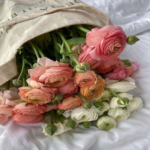Dealing With Pests
Plants pests are an annoying, but unfortunately unavoidable part of plant parenthood. The good news is that bugs are not a sign of poor…
Plants pests are an annoying, but unfortunately unavoidable part of plant parenthood. The good news is that bugs are not a sign of poor plant care, neglect, or an unsavory nursery – in fact they can remain invisible to even the greenest of thumbs when we inspect our plants prior to purchasing. They’re natural and all plant owners will eventually have to deal with them.
One of the best methods to limit the spread of pests is to isolate new plants when you bring them home from the nursery. By isolating a plant for a week or two you’ll be able to monitor the plant and ensure that it won’t spread bugs once it’s introduced to the rest of your plants. Isolation is also the first step if you discover pests on a plant. Immediately remove it to lessen the chance the pests will spread.
One misconception we often hear when pests are discovered on a plant is that their plants were clean to begin with so it must be ‘X’ new plant that caused the issue. Unfortunately plant pests can be introduced into your home in many ways, and some plants are particularly susceptible, meaning that even after treatment the particular pest may come back.
Spider Mites: Spider Mites are tiny little bugs that like to hang out on the bottom side of leaves and plant stems. They can be white, red, or brown, and are often identifiable by the webbing they leave at the base of the leaf where it meets the stem. Spider mites are tiny and are able to float on the wind or grab onto clothing, meaning that they can float right in to your home through open windows or be transferred from clothing.
Spider Mites have a reputation as difficult to get rid of because they need to be treated for all stages of their life cycle. It is possible to treat spider mites with insecticidal soap. Start by wiping down the leaves and removing as many bugs and webbing as possible. Spray the plant thoroughly with the soap solution every day for nine days to ensure the spider mites are killed.
Mealybugs: Mealybugs are one of the easiest pests to spot as they are larger than most common houseplant pests. White and fuzzy, Mealybugs look like little spots of cotton and attach themselves to the plant, leaching nutrients.
Mealybugs are relatively easy to get rid of using most pesticides, horticulture oils, or even rubbing alcohol. For a few bugs you can dip a cotton swab in your pesticide and touch it to the bug, but for larger issues you can spray down the plant thoroughly with mealybug powder solution in a spray bottle.
Fungus Gnats: Fungus Gnats are less destructive than other common plant pets, yet they may be the most annoying. These little flying pests often appear when soil is very moist, often when plants are being overwatered. They look like little fruit flies.
Correcting overwatering will help eliminate these bugs as the fungus they eat grows on very damp soil. You can also mix some Diatomaceous Earth into the top inch of soil. It won’t hurt your plant but will help clear up your gnat problem.
Scale: Scale bugs are small white pests that attach themselves to plants. Their hard wax shells appear like little fish scales on the plant – often cacti or succulent varieties.
While scale can be pretty destructive to plants, they can simply be scraped off the plant. Their hard shells make pesticides and sprays less effective.
Related


Dealing With Pests
Dealing with Plant Pests Plants pests are an annoying, but unfortunately unavoidable part of plant parenthood. The good news is that bugs are not…

Dealing with Plant Pests
Plants pests are an annoying, but unfortunately unavoidable part of plant parenthood. The good news is that bugs are not a sign of poor plant care, neglect, or an unsavory nursery – in fact they can remain invisible to even the greenest of thumbs when we inspect our plants prior to purchasing. They’re natural and all plant owners will eventually have to deal with them.
One of the best methods to limit the spread of pests is to isolate new plants when you bring them home from the nursery. By isolating a plant for a week or two you’ll be able to monitor the plant and ensure that it won’t spread bugs once it’s introduced to the rest of your plants. Isolation is also the first step if you discover pests on a plant. Immediately remove it to lessen the chance the pests will spread.
One misconception we often hear when pests are discovered on a plant is that their plants were clean to begin with so it must be ‘X’ new plant that caused the issue. Unfortunately plant pests can be introduced into your home in many ways, and some plants are particularly susceptible, meaning that even after treatment the particular pest may come back.
Spider Mites: Spider Mites are tiny little bugs that like to hang out on the bottom side of leaves and plant stems. They can be white, red, or brown, and are often identifiable by the webbing they leave at the base of the leaf where it meets the stem. Spider mites are tiny and are able to float on the wind or grab onto clothing, meaning that they can float right in to your home through open windows or be transferred from clothing.
Spider Mites have a reputation as difficult to get rid of because they need to be treated for all stages of their life cycle. It is possible to treat spider mites with insecticidal soap. Start by wiping down the leaves and removing as many bugs and webbing as possible. Spray the plant thoroughly with the soap solution every day for nine days to ensure the spider mites are killed.
Mealybugs: Mealybugs are one of the easiest pests to spot as they are larger than most common houseplant pests. White and fuzzy, Mealybugs look like little spots of cotton and attach themselves to the plant, leaching nutrients.
Mealybugs are relatively easy to get rid of using most pesticides, horticulture oils, or even rubbing alcohol. For a few bugs you can dip a cotton swab in your pesticide and touch it to the bug, but for larger issues you can spray down the plant thoroughly with mealybug powder solution in a spray bottle.
Fungus Gnats: Fungus Gnats are less destructive than other common plant pets, yet they may be the most annoying. These little flying pests often appear when soil is very moist, often when plants are being overwatered. They look like little fruit flies.
Correcting overwatering will help eliminate these bugs as the fungus they eat grows on very damp soil. You can also mix some Diatomaceous Earth into the top inch of soil. It won’t hurt your plant but will help clear up your gnat problem.
Scale: Scale bugs are small white pests that attach themselves to plants. Their hard wax shells appear like little fish scales on the plant – often cacti or succulent varieties.
While scale can be pretty destructive to plants, they can simply be scraped off the plant. Their hard shells make pesticides and sprays less effective.
Related


- 250.571.1479
- [email protected]
- 353 Victoria St, Kamloops BC V2C 2A3
- We would like to respectfully acknowledge that we live and work on the traditional and unceded territory of the Tk′emlúps te Secwépemc people.
About
- Our Story
- Plant Club
- Affiliates
- Wholesale
- Press
- Local Artists
Show us In Your Home!
Tag us @farandwideshop! We love to see you how you use, style & repurpose our products, and we might feature you!
Store Hours
Monday to Friday 10 – 5:30
Saturday + Sunday 10 – 4
Privacy Overview
| Cookie | Duration | Description |
|---|---|---|
| cookielawinfo-checkbox-analytics | 11 months | This cookie is set by GDPR Cookie Consent plugin. The cookie is used to store the user consent for the cookies in the category "Analytics". |
| cookielawinfo-checkbox-functional | 11 months | The cookie is set by GDPR cookie consent to record the user consent for the cookies in the category "Functional". |
| cookielawinfo-checkbox-necessary | 11 months | This cookie is set by GDPR Cookie Consent plugin. The cookies is used to store the user consent for the cookies in the category "Necessary". |
| cookielawinfo-checkbox-others | 11 months | This cookie is set by GDPR Cookie Consent plugin. The cookie is used to store the user consent for the cookies in the category "Other. |
| cookielawinfo-checkbox-performance | 11 months | This cookie is set by GDPR Cookie Consent plugin. The cookie is used to store the user consent for the cookies in the category "Performance". |
| viewed_cookie_policy | 11 months | The cookie is set by the GDPR Cookie Consent plugin and is used to store whether or not user has consented to the use of cookies. It does not store any personal data. |


